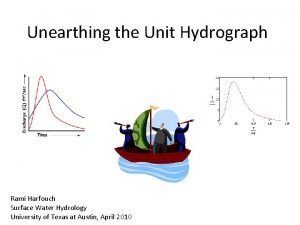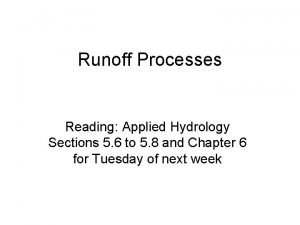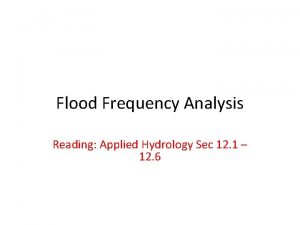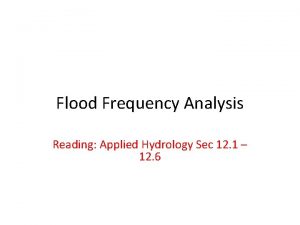Frequency Analysis Reading Applied Hydrology Sections 12 2










- Slides: 10

Frequency Analysis Reading: Applied Hydrology Sections 12 -2 to 12 -6

Frequency analysis for extreme events Q. Find a flow (or any other event) that has a return period of T years EV 1 pdf and cdf Define a reduced variable y If you know T, you can find y. T, and once y. T is know, x. T can be computed by 2

Example 12. 2. 1 • Given annual maxima for 10 -minute storms • Find 5 - & 50 -year return period 10 -minute storms 3

Frequency Factors • Once a distribution has been selected and its parameters estimated, then how do we use it? • Chow proposed using: • where f. X(x) x 4

Normal Distribution • Normal distribution • So the frequency factor for the Normal Distribution is the standard normal variate • Example: 50 year return period Look in Table 11. 2. 1 or use –NORMSINV (. ) in EXCEL or see page 390 in the text book 5

EV-I (Gumbel) Distribution 6

Example 12. 3. 2 • Given annual maximum rainfall, calculate 5 -yr storm using frequency factor 7

Probability plots • Probability plot is a graphical tool to assess whether or not the data fits a particular distribution. • The data are fitted against a theoretical distribution in such as way that the points should form approximately a straight line (distribution function is linearized) • Departures from a straight line indicate departure from theoretical distribution 8

Normal probability plot • Steps 1. Rank the data from largest (m = 1) to smallest (m = n) 2. Assign plotting position to the data 1. Plotting position – an estimate of exccedance probability 2. Use p = (m-3/8)/(n + 0. 15) 3. Find the standard normal variable z corresponding to the plotting position (use -NORMSINV (. ) in Excel) 4. Plot the data against z • If the data falls on a straight line, the data comes from a normal distribution. I 9

Normal Probability Plot Annual maximum flows for Colorado River near Austin, TX The pink line you see on the plot is x. T for T = 2, 5, 10, 25, 50, 100, 500 derived using the frequency factor technique for normal distribution. 10



















